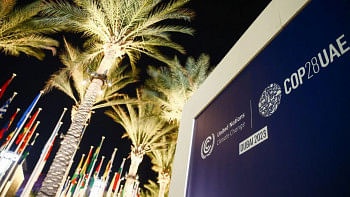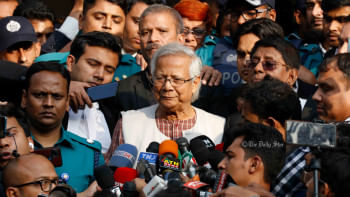No gender justice without climate justice

Whenever we discuss violence against women or gender-based violence, our point of view still seems to be patriarchal and limited. We fail to accommodate the existing structural discrimination and global risks, such as climate change, in the discussions. How are we supposed to study this "violence"? Should it be limited to domestic abuse, child marriage, dowry, sexual harassment, rape, and the absence of social rights?
Women have been practising regenerative natural agriculture for millennia. In the 60s, we were forced to adopt the green revolution, and now, the threat of chemical toxins and plastic pollution is everywhere. Female health faces tremendous risks, so do their cultural rights. Then, should we not study this system of development as "violence" against women?
In fact, if important matters—such as the fact that the climate crisis is sustaining the persecution and oppression of women or even provoking gender discrimination—are not discussed, there is no way that violence against women will stop.
From November 25 to December 10, the world observed 16 Days of Activism against Gender-Based Violence. Meanwhile, the 28th UN Climate Change Conference, or COP28, started on November 30 and will end tomorrow. I want to take this opportunity to speak about such risks, especially the oppression of women.
Climate and gender activists worldwide are bringing up these topics in various ways. Climate justice is not possible without gender justice, and at the same time, if you want to establish gender justice, climate justice is a must-have. Let's try to understand this using the variety of experiences accumulated from various parts of the world at COP28.
"Climate change" is a natural process, but the "climate change" that is spoken about copiously is not at all natural. The latter is the result of carbon emissions coming from the rich and their luxurious lifestyle. Earth today is a burning, boiling planet. This drastic change that has been inflicted on the world is not outside the structures of colonialism, discrimination, justice and power. One of these structures is patriarchal development, which has encroached upon nature. The intolerable consequences of this are being faced by all living things, societies, and ecosystems in our world—and women are one of the worst sufferers.
Yet, rural women are one of the most notable architects of agriculture and natural conservation around the world. For the women who rely on agriculture and natural resources, their livelihoods, conventional knowledge, social harmony, and cultural heritage are all under threat because of climate change. This is why climate change is an instance of patriarchal oppression. It is impossible to combat climate change through the lens of patriarchy; society, the state and agencies must be freed of this discriminatory lens.
Climate crisis and conservation must be viewed through the lens of globally vibrant social and natural diversity, and the lens of gender is vital. It is important to discuss how climate change makes violence against women more extreme and brutal.
The narrations of Khona, an astrologer and scientist from ancient Bengal, have been an important tool in practising the understanding of weather and agriculture. In fact, traditional proverbs, folklore, folk music, rural narratives, and all forms of folk wisdom have acted as a library in the art of studying the weather. But unfortunately, we have misplaced this library of folk wisdom. One of the biggest reasons behind this is our discriminatory mindset and patriarchal sense of bravado. The spread and growth of the knowledge of seedlings, of safe sources of water, of forest resources or the enormous amount of genetic resources around the world, these have all happened due to the contributions of women. But today, rural women have next to no access to agricultural knowledge and resources.
Climate change is pushing women further towards the precipice of social violence and natural risks. In Bangladesh, cyclones, floods, river erosion, the drying of mountain streams, stone quarrying, mudslides, extreme heat waves, droughts, salinity, cold waves, excessive and irregular rain and hail storms have changed the production and livelihood patterns of rural women. Moreover, among climate refugees who make their ways into the slums of cities, women and children are most at risk. In the city, a rural farmer, fisherwoman or a handicraft artist has no social identity. And all of this increases the amount of physical, mental and social violence towards women.
What do the experiences of Bangladeshi women in the coastal regions, in haors, chars or mountains tell us? Each region is going through an extreme water crisis, and and the situation is worsening day by day. A woman has to walk miles for a pitcher of water, and this excessive workload is gnawing away at their work hours. In Dubai, during the climate summit, the painful picture of rural women standing in long queues to get water was shown in the Bangladesh pavilion. It is equally important to answer the question of why it must be women who collect the water.
Among climate refugees who make their ways into the slums of cities, women and children are most at risk. In the city, a rural farmer, fisherwoman or a handicraft artist has no social identity. And all of this increases the amount of physical, mental and social violence towards women.
In coastal regions of Bangladesh, salinity has meant that the reproductive health of young girls and women is at risk. Women from a poor background have to fish in saline water, and their household chores are done using this water as well. This has led to a rise of diseases of the reproductive system. Many women are suffering from ovarian tumours or cancer; many have to go through hysterectomies.
Shefali Bibi, a woman from Datinakhali village in Satkhira's Shyamnagar, has gone through a similar ordeal. I met Shefali, who was ill, before coming to the Dubai climate summit. She told me that many women in her village are suffering from various illnesses because of salinity. In patriarchal cultures, diseases of the female reproductive system are kept secret as "womanly problems." Hence, the heartless suffering of these women has been unknown to the world.
This year, after the cyclones Mocha, Hamoon, Tej, and Midhili, the coastal regions are now reeling from Michuang. After surviving all these climate-induced disasters, how are the women supposed to look after their health? In Shefali Bibi's house, the girls said that they suffer more during their periods now. Society does not pay heed towards the safe reproductive health of women, so women have suffered for generations because of the practice of reusing old pieces of cloth.
Meanwhile, cyclones, waterlogging, and saline water are pushing men away from the agricultural livelihoods of villages for brick kilns in the cities. This leaves the women to look after the households, which is also leading to social violence.
Before coming to the climate summit, I had the chance to speak to day labourers Binodini Munda from the coastal region and Chichilia Hembrom from the northern Barind region. Even though they live in different parts of the country, they both face extreme water crisis because of climate change. They have to contend with the new anxiety of possibly having to leave their birthplaces. Many such stories of struggle and discrimination of climate-struck women in Bangladesh were heard at the Dubai climate summit.
At the summit, I interviewed Dr Joyce M Mutinda, chairperson of National Gender and Equality Commission in Kenya. She told me that climate-induced crises are increasing the risks of violence against women. Due to droughts, rural women need to go far to collect water, dig up sand, or collect firewood. So, they cannot prepare food timely, which creates family-based violence, she said, mentioning that without climate justice, we cannot achieve gender justice, as these are interconnected.
If global temperatures cannot be kept under 1.5 degrees Celsius, small countries like Trinidan and Tobago, Fiji, the Maldives, and Antigua and Barbuda may sink due to rising sea levels. On the bus to the hotel from the summit, I spoke to Ruth Viola Spencer, deputy chair of Marine Ecosystems Protected Area Trust. She said 80 percent of the people in Antigua and Barbuda are dependent on the tourism industry. In Antigua, many families are headed by women, but gender-based violence still exists there. Climate change has led to a water crisis there. Hotels have water supply, but villages don't, and failure to collect water is leading to various forms of domestic violence for women.
I also spoke with Diane Sibanda, a farmer from a village called Mokubani in the African country of Botswana. A member of the Balete ethnic group, this woman farms tomatoes, cauliflower, cabbages, onions, pumpkins, and a local variety of cricket called Tswana. Extreme heatwaves and low rainfall has reduced her production rates and the soil has also turned infertile. Because of these reasons, she sustained a loss of almost 250,000 pula last year. In her society, the bride's family has to pay money during a wedding. But the financial losses due to climate change are creating problems for the survival of women.
On December 4, an official side event was held at the climate summit, titled "Why is militarisation one of the key obstacles to mitigating the climate crisis?" There, the speakers talked about how war and militarisation created new critical risks and conflicts. Conflicts increase violence against women. They suggested that demilitarisation and the end of war can be a climate solution from the perspectives of climate-vulnerable women in the Philippines, Vietnam, Syria or Gaza Strip.
Cop28 has started with the commitment for a Loss and Damage Fund. Until the third day of the summit, only $655 million had been committed to it. Mamta Baragayari, a representative of international organisation Sea Changes Climate, said, "This fund that has been committed so far is in no way enough. We must discuss how this fund will be brought to the real people who are at risk, and to women. The climate crisis is definitely a crisis of leadership. In the global climate negotiations, women don't have active participation."
Sineia Wapichana, leader of Brazil's Indigenous Council of Roraima, said, "We have heard many commitments about the climate fund at various climate summits. But the indigenous people of the Amazon have not received these funds. The climate induced contests between indigenous peoples in the Amazon have led to an increased life risk for women there. Indigenous women need to be part of these climate discussions."
I met some youth representatives from Bangladesh at the climate summit too. There, I spoke to Shakila Islam, co-founder of Bangladesh Youthnet, about climate change and violence against women. She thinks that, even though the summit is showcasing women, they still haven't ensured active participation. From her experience of working with rural girls in Khulna and Barishal, she said, "The water crisis in coastal regions is so bad that people don't want to get married to other people in those areas."
We hope that in climate or gender discussions, the risk and violence faced by women due to climate change will be given its due importance. Masking of any type of risk or violence cannot ensure gender or climate justice.
Translated from Bangla by Azmin Azran.
Pavel Partha, an ecology and biodiversity conservation researcher, is director at Bangladesh Resource Centre for Indigenous Knowledge (BARCIK).He can be reached at [email protected].
Views expressed in this article are the author's own.
Follow The Daily Star Opinion on Facebook for the latest opinions, commentaries and analyses by experts and professionals. To contribute your article or letter to The Daily Star Opinion, see our guidelines for submission.

 For all latest news, follow The Daily Star's Google News channel.
For all latest news, follow The Daily Star's Google News channel. 










Comments